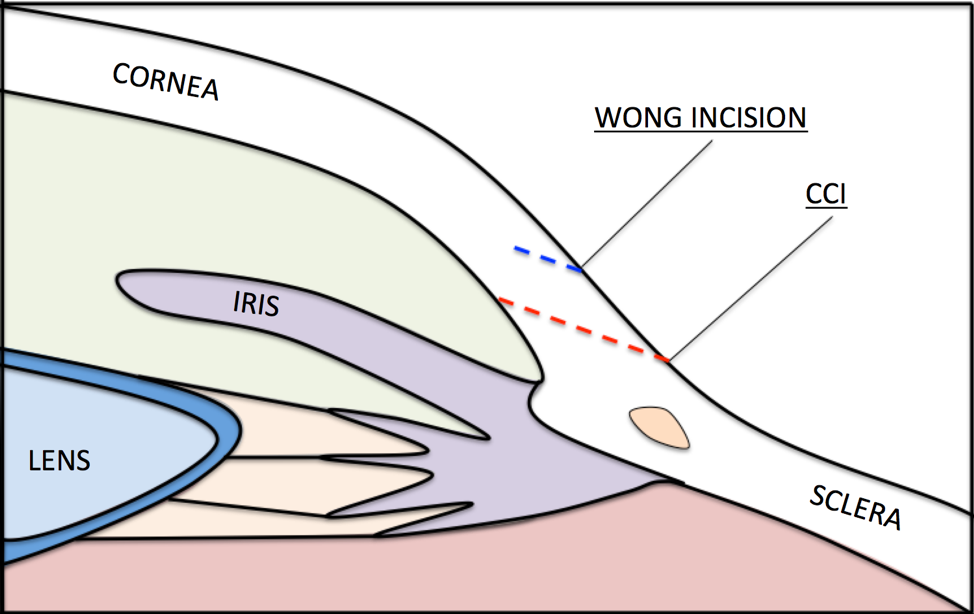Hydration of the Clear Corneal Incision and the Wong Pocket
Home / Ophthalmic Surgery / Lens and Cataract Surgery
Title: Hydration of the Clear Corneal Incision and the Wong Pocket
Authors: Troy Teeples, MSIV, Tara Hahn, MD, Nikko Ronquillo, MD, Jeff Pettey, MD
Photographer: Troy Teeples, MSIV
Date: 8/7/2018
Keywords/Main Subjects: Wound hydration, Wong Pocket, clear corneal incision, hydration, hydration fill
Brief Description: Hydration is a common technique used to create a watertight seal of the Clear Corneal Incision (CCI) at the end of cataract surgery. Here we describe how to hydrate the CCI with and without filling the anterior chamber. We also describe an alternative technique to create a watertight seal using the Wong Pocket.
Introduction:
After completion of phacoemulsification of the lens nucleus and IOL insertion, a watertight seal of corneal wounds is needed to prevent possible post-operative complications including wound-leakage, anterior chamber collapse and post-operative endophthalmitis. Hydrating the corneal stroma with BSS is the conventional method given its relative ease of use. When hydrating a wound, it is sometimes necessary to fill the anterior chamber with BSS to increase the IOP. Here we describe a technique to hydrate the wound with and without filling the anterior chamber by simple manipulation of the angle of the canula.
A second technique to ensure a watertight seal of the CCI is by creating a Wong Pocket. A Wong Pocket is a small, partial-thickness corneal incision anterior to the CCI formed at the beginning of cataract surgery. At the conclusion of the case, the Wong Pocket is hydrated, thus creating an inward pressure on the CCI. The combined inward pressure generated by the Wong Pocket and outward pressure from the IOP of the anterior chamber create a secure, long-lasting seal of the corneal wound.
Description of Technique:
Hydration Fill: To start, a 30-gauge half-inch canula is attached to a 2mL syringe filled with a balanced salt solution. In order to seal the CCI, the canula is advanced into the lateral wall of the incision at a 90-degree angle. It is important that the cannula is pushed directly to the stroma and not to the anterior chamber. BSS is then injected into the corneal stroma until diffuse whitening occurs, after which these steps are repeated on the other side of the incision. This allows for hydration of the incision without filling the anterior chamber. When filling the anterior chamber with BSS is necessary at this step, the cannula is simply angled towards the anterior chamber (> 90 degrees, as shown in the video).
Wong Pocket: In order to create a Wong Pocket, a 1.5mm – 2mm partial-thickness corneal incision (forming an equilateral triangle with its base towards the limbus) is created using a diamond or metal keratome. This pocket should be both superior and anterior to the intended CCI and have a depth of roughly one half the stromal thickness. At the conclusion of the case, a 30-gauge cannula filled with BSS is pointed downwards and inserted into the Wong Pocket. BSS is then injected, thus hydrating the ‘roof’ of the CCI and creating a watertight seal.
Image Description: Cartoon depicting the location of the Wong Pocket, created before the clear corneal incision (CCI).
Faculty Approval by: Jeff Pettey, MD
Identifier: Moran_CORE_25242
Copyright statement: Copyright Teeples, ©2018. For further information regarding the rights to this collection, please visit: http://morancore.utah.edu/terms-of-use/
Disclosure (Financial or other): None




